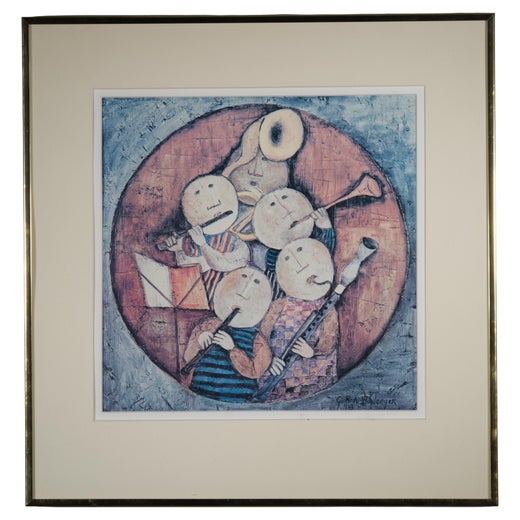Graciela Rodo BoulangerLes Petit Rats, Ballerinas IIIc.1980
c.1980
About the Item
- Creator:Graciela Rodo Boulanger (1935, Bolivian)
- Creation Year:c.1980
- Dimensions:Height: 36 in (91.44 cm)Width: 30.75 in (78.11 cm)Depth: 1.25 in (3.18 cm)
- Medium:
- Movement & Style:
- Period:
- Condition:
- Gallery Location:San Francisco, CA
- Reference Number:Seller: bou/bal/031stDibs: LU66639827732
Graciela Rodo Boulanger
Graciela Rodo Boulanger was born in 1935 in La Paz, Bolivia. From an early age, she was surrounded by art and music due in part to her mother being a concert pianist and her father an art connoisseur. By the age of 17, she had studied both in Chile and Vienna and had exhibited paintings and given piano recitals in over five countries. At 22 she made the difficult decision to abandon her musical studies in order to devote all of her time and energy to painting and making prints.
In 1960, Boulanger held an exhibition in Argentina where she became one of the winners of the First Latin American Xylography Competition. (Xylography is a form of woodblock printmaking.) After viewing an etching by Johnny Friedlaender, she moved to Paris in 1961 where she studied under the renowned artist. During this time, she was able to improve upon her style and technique as well as gain worldwide recognition for her oil paintings, etchings and lithographs.
In 1966, Boulanger first exhibited in the United States and began to publish editions of her engravings. Within two short years, she had established her own etching studio.
In 1979, Boulanger was designated by UNICEF as the official artist for the "International Year of the Child" poster. The Metropolitan Opera of New York commissioned Boulanger's poster for their performance of Mozart's The Magic Flute in 1986. The World Federation of the UN Associations chose one of Boulanger’s paintings in 1993 to use on a stamp and as a limited-edition print. The proceeds benefitted the preservation of endangered species.
In 2005, Boulanger left Paris and moved back to her home in La Paz, Bolivia, where her daughter Sandra and her grandchildren have been a constant source of inspiration for her art.
Today Boulanger’s work, which is known worldwide for the artist’s stylized treatment of the continuous theme of children, can be seen in museums such as La Bibliotheque Nationale in Paris, the Modern Art Center in Zurich and the Museum of Modern Art of Latin America. Boulanger has participated in more than 150 exhibitions on all five continents.
Find original Graciela Rodo Boulanger prints and other art for sale on 1stDibs.
(Biography provided by R Alexander Fine Art)
You May Also Like
Early 2000s Modern Figurative Prints
Watercolor, Archival Paper, Lithograph
1930s American Modern Portrait Prints
Lithograph
Caroline DurieuxPlayboys (2 American male refugees from the Gatsby era preen on Mexican beach), 1936
1950s Modern Figurative Prints
Lithograph
21st Century and Contemporary Modern Figurative Prints
Lithograph
1940s American Modern Landscape Prints
Lithograph
Late 20th Century American Modern Figurative Prints
Lithograph
1940s American Modern Figurative Prints
Lithograph
1960s American Modern Nude Prints
Lithograph
1920s American Modern Figurative Prints
Lithograph
1960s Modern Figurative Prints
Lithograph
More From This Seller
View AllLate 20th Century Modern Figurative Prints
Lithograph
Mid-20th Century Modern Figurative Prints
Lithograph
Mid-20th Century Modern Figurative Prints
Lithograph
Mid-20th Century Modern Figurative Prints
Lithograph
Late 20th Century American Modern Still-life Prints
Lithograph
Late 20th Century Modern Landscape Prints
Lithograph
